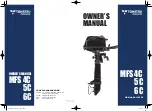MPC555
/
MPC556
BURST BUFFER
MOTOROLA
USER’S MANUAL
Rev. 15 October 2000
4-13
code compression, and is a result of the statistical study.
illustrates the
binary decode tree for specific instructions.
Figure 4-12 Bounded Huffman Code Tree
In
, instruction “a” would require two bits. The bypass node would require
four bits. The bounded form of the Huffman code tree is limited in size for implemen-
tation into hardware. The largest compressed instruction is 36 bits — four bits for the
bypass mode plus the normal uncompressed 32-bit instruction.
4.3.9 Decompression
• The instruction code is stored in the memory in the compressed form
• The decode vocabulary is stored in the burst buffer controller (BBC).
• The decompression is done on-line by the dedicated decompressor unit in the
BBC.
• Decompression flow: (See
— RCPU provides a
“bit aligned COF
1
address”
to the BBC.
— ICDU:
• Converts COF address to
“word aligned physical address”
to access the
memory
• Fetches the compressed instruction code data from the memory, decom-
presses it and delivers
“non-compressed instruction code”
together with
the bit aligned
“next instruction address”
to the RCPU, that uses it for sub-
routine and exceptions handling.
• When instructions are running without a COF, the next instruction is pre-
fetched and decoded in the current cycle. This eliminates any delays from
code compression during regular sequential (non-COF) operation.
1.
COF = Change of Flow
BYPS_node
b
c
a
d
e
h
g
f
An “a” instruction half
requires less bits
than an “h” instruction
half.
A bypass instruction
requires four bits.
= another bit
= Instruction location
F
re
e
sc
a
le
S
e
m
ic
o
n
d
u
c
to
r,
I
Freescale Semiconductor, Inc.
For More Information On This Product,
Go to: www.freescale.com
n
c
.
..


















